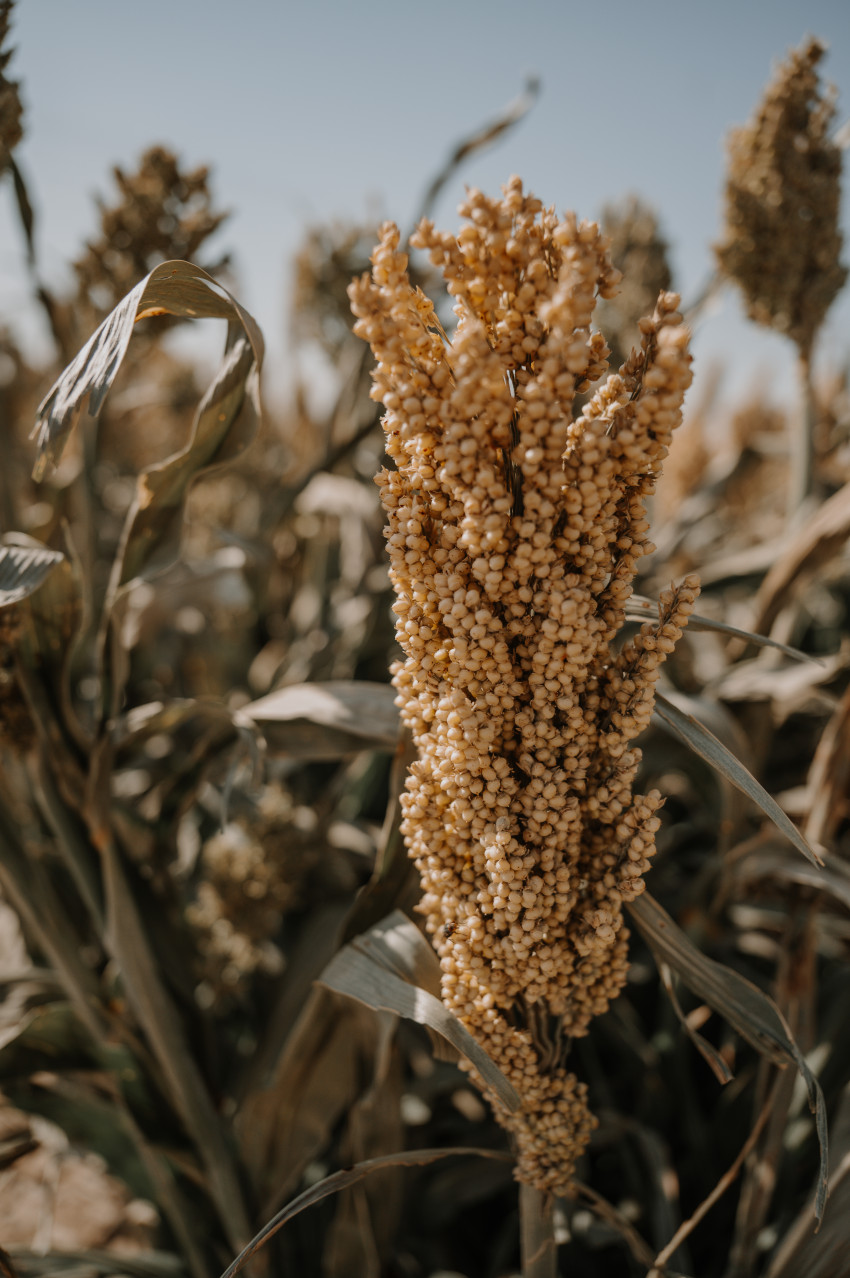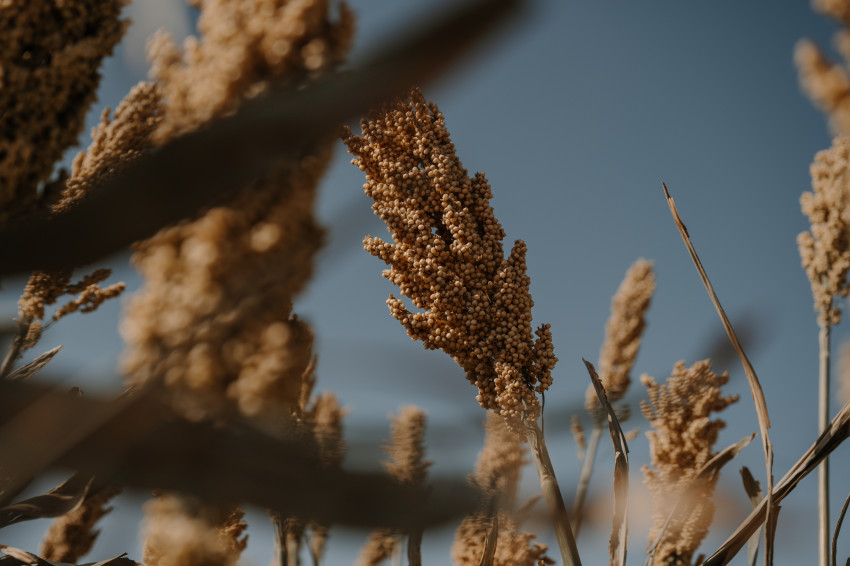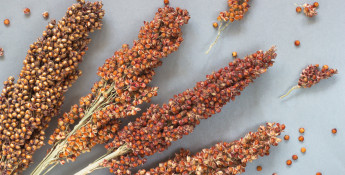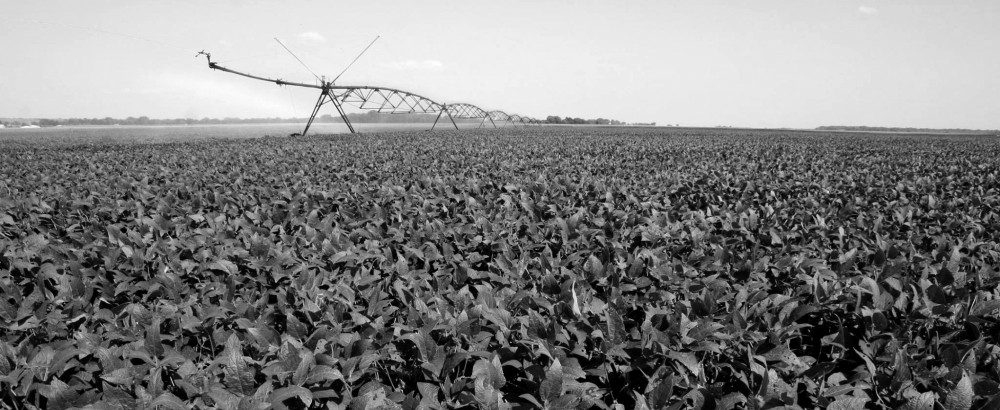By Sheridan Wimmer on August 5, 2025
Milo makes an impact on every step of Kansas’ food supply chain
Kansas farmers hold the No. 1 rank in sorghum production
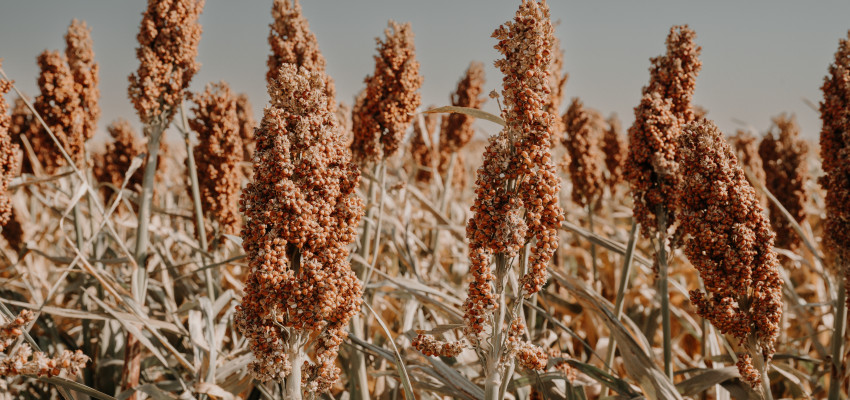
Kansas farmers hold the No. 1 rank in sorghum production Harvey County Kansas is widely known for its wheat: The vast fields of golden grain that dance in the wind are akin to a coastal town’s ocean waves. But another Kansas crop’s deep red panicles make it equally beautiful despite its itchinducing leaves and seed heads that are covered in tiny, hair-like trichomes. That itchy but stunning plant is milo.
Many people use the terms “milo” and “sorghum” interchangeably, but farmers in Kansas will correct them on the terminology. Milo is the correct noun in the countryside.
“We kind of have an identity crisis,” Macey Mueller, who farms with her family in Harvey County, jokes. “For marketing purposes, sorghum is what we tend to call the crop, and it’s not going to change, but before I joined the Sorghum Checkoff Board, I rarely called it sorghum. It was always milo.”
HISTORY ROOTED IN ADAPTABILITY
Grain sorghum (milo to the farmers) originated in Africa and is now considered an ancient grain. Its drought-tolerant attributes make it well suited to the patchy, unpredictable nature of Kansas precipitation, and it has found a footing in livestock feed, ethanol fuel and gluten-free food products for humans.
According to the book Crop Production: Evolution, History and Technology by C. Wayne Smith, deliberate introduction of sorghum began in 1857 to produce syrup. Other early sorghums ranged from a brown and white seed called “gyp corn,” a kafir type and milo maize. As farmers learned corn was a difficult crop for the arid areas of the Midwest, they turned to grain sorghum to grow as feed for livestock. By 1890, 23 varieties of sorghum were available to growers in the “Sorghum Belt,” which runs from Texas to South Dakota.
Although these sorghum varieties have diversified over time, milo was a type of sorghum cultivated throughout the U.S. starting in the 1800s, and the name stuck.
AN IMPORTANT CROP FOR KANSAS GROWERS
Today, Kansas holds the No. 1 rank in state production of milo/sorghum. The United States Department of Agriculture estimates Kansas’ 2024 milo production to be 182 million bushels, up 8 percent from 2023. Trade is essential to Kansas farmers: Nearly half of the state’s sorghum is exported, primarily to China but also to other countries such as Mexico and Japan. In April, President Donald Trump imposed a minimum 10 percent tariff on products imported from almost all countries, and even higher for some countries. However, under the United States- Mexico-Canada Agreement (USMCA), agricultural products covered by the agreement, including sorghum, remain tariff-free when traded between the U.S., Mexico and Canada. Despite this, other key trading partners like China are not bound by USMCA rules and can impose retaliatory tariffs. In response to U.S. trade actions, China implemented a 10 percent tariff on U.S. sorghum imports as part of a truce. However, tariff negotiations change rapidly and retaliatory tariffs could mean higher percentages if agreements aren’t reached. The impact of international trade and tariffs from other countries will be felt by families like the Muellers who rely on sorghum exports.
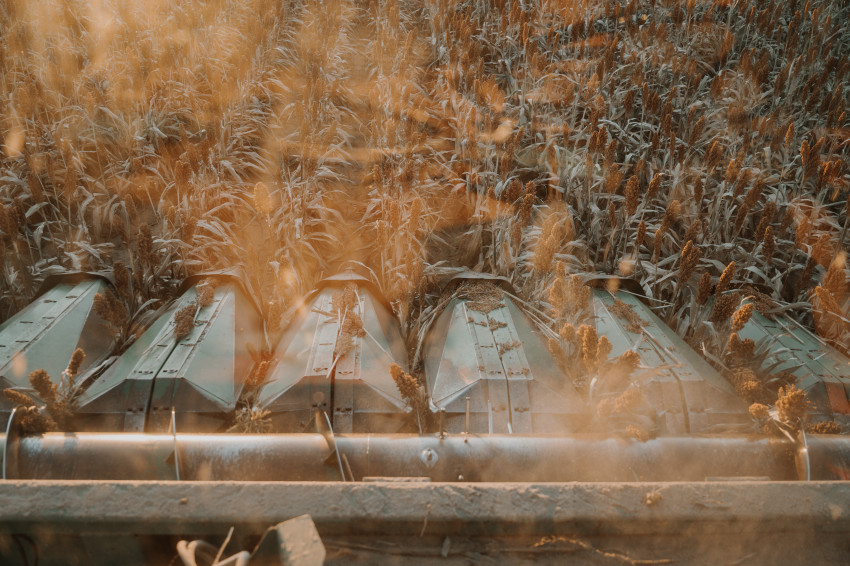 “While we know there’s always room for improvement, maintaining positive trade relations with key partners is vital to not only the sorghum industry in the United States, but the entire agricultural system as a whole,” Macey says. “When tariffs are imposed, countries might look elsewhere to supply their needs or pay less to account for tariffs. Less demand for U.S. sorghum can mean higher pressure on us.”
“While we know there’s always room for improvement, maintaining positive trade relations with key partners is vital to not only the sorghum industry in the United States, but the entire agricultural system as a whole,” Macey says. “When tariffs are imposed, countries might look elsewhere to supply their needs or pay less to account for tariffs. Less demand for U.S. sorghum can mean higher pressure on us.”
One of sorghum’s key selling points for trading partners is it remains a non-genetically modified (GM) crop. While most of the U.S. agriculture industry stands behind GM products and their safety, other countries that are essential importers of U.S. agricultural products restrict the import and practice of growing genetically modified organisms (GMOs).
“Over the years, this has been a discussion in the sorghum industry,” Macey says. “But since other countries adopt non-GMO restrictions, it gives U.S. sorghum farmers a market. Checkoff research dollars have allowed scientists to improve sorghum without turning to genetic modification so far. While the discussions are ongoing, sorghum being non-GMO differentiates it and makes it attractive to global trading partners.”
Even with uncertainty in the markets, sorghum has been part of the Muellers’ growing rotation for four generations and will continue to be a crop they grow.
“I’m the fourth generation on our family farm,” Josh Mueller, Macey’s husband, says. “Milo has always been in our rotation, even as soybeans and corn became more popular, because it’s so well suited to our area and provides a desirable fall forage for our cattle operation.”
WATER EFFICIENCY AND SUSTAINABILITY MEASURES
Water has been a topic of discussion among Kansas farmers, consumers and legislators. The Ogallala Aquifer is one of the world’s largest groundwater sources, and farmers continuously seek solutions to slow its rate of depletion. Harvey County, where the Muellers farm, sits on the edge of the aquifer. While milo is sometimes irrigated in Kansas, it offers farmers a harvestable crop that doesn’t require as much water as other grains. The issue with the Ogallala is the extreme drought Kansas has seen the past several years — without rain, the Ogallala can’t replenish.
“Even as the Sorghum Belt has shifted a bit more west, we’re still on the edge of it here in Harvey County,” Josh says. “When we’re thinking about what to grow in the next year, we consider the current ground moisture levels and the expected precipitation for the growing season. If we’re worried about moisture, milo may be more attractive for us.”
Water efficiency is one of milo’s many attributes, and it underscores the Muellers’ dedication to sustainability efforts. While sustainability has different definitions depending on who you ask, for the Muellers, it’s about forward thinking and being open-minded.
“Farmers are the epitome of sustainability,” Josh says. “Every farmer is playing for the future and wants the next generation to be able to hit the ground running and move forward. We want to leave it better for the next generation, so whether that’s with farming practices or erosion control, for example, we want to improve each piece of land as much as we can.”
Josh and Macey are raising their four children (three pictured here) — Conway, Raleigh, GG and Coral — as the fifth generation on their farm and ranch and want to set them up for success if they choose to stay involved in the operation, which is the same opportunity Josh’s dad gave him. They may have different opinions on farming practices from time to time, but ultimately, they share the goal of building a legacy.
“I think you need to be open-minded,” Josh says of farming decisions made each year. “You don’t want to have blinders on from year to year and say, ‘Well, this is the way we did it last year, so this is the way we have to do it this year.’ I think the more flexibility you can have, the better.”
“Farmers are the epitome of sustainability,” Josh says. “Every farmer is playing for the future and wants the next generation to be able to hit the ground running and move forward. We want to leave it better for the next generation, so whether that’s with farming practices or erosion control, for example, we want to improve each piece of land as much as we can.”
A GROWING MARKET FOR FOOD-GRADE SORGHUM
Flexibility is milo’s superpower. Beyond livestock feed, which is the typical application for the red berries you see across the state in the fall, milo is gaining attention in food-grade markets, which represent the human-consumption side of food production.
Different types of sorghum range from grain sorghum — including red, orange, bronze, tan, white and black sorghum — to forage sorghum, biomass sorghum and sweet sorghum. Typically, the tan-, cream- and white-colored sorghum varieties are milled into flour for the food industry. Black and burgundy varieties contain beneficial antioxidant properties that help protect your body from damage caused by stress and aging.
As a board member of the United Sorghum Checkoff Program — a national organization established to promote the growth, research and development of the sorghum industry — Macey has gained an inside look at milo’s various applications. Human consumption is an exciting opportunity for the industry.
“Places like Nu Life Market in Scott City source specific varieties of sorghum, like white- or cream-colored sorghum, for their food-grade processes,” Macey says. “And from a checkoff perspective, we’re working and investing dollars in human consumption research. It’s a nutrient-dense food and has many antioxidants, vitamins, minerals and is known as one of the higher protein grains. When consumers are looking for something that’s non-GMO and naturally gluten free, it fits the bill.”
Sorghum has about the same amount of protein as quinoa — approximately 4 grams per 100 grams cooked — but tops white rice with fewer calories, higher protein content and higher fiber.
BRINGING NEW LIFE TO CONSUMER DEMAND
Nu Life Market is a leading producer of food-grade sorghum products. Founded in 2007 by Earl Roemer, the company partners with area milo farmers to make sorghum flours, whole grains and syrups, catering to a growing demand for allergen-friendly food options. In recognition of its contributions, the company received the 2024 Governor’s Award of Excellence.
 “It was a great honor to be recognized for all the things we do, especially transitioning sorghum into the food applications versus feed applications,” Roemer says. “Consumers demand the product.”
“It was a great honor to be recognized for all the things we do, especially transitioning sorghum into the food applications versus feed applications,” Roemer says. “Consumers demand the product.”
Nu Life Market’s products range from all-purpose and pizza crust flour to popped sorghum — similar to popcorn — and even baby food. They take their commitment to providing allergen-free products very seriously.
“We’re at the highest level of food safety,” Roemer says. “We’re FSSC 22000 standard, which is a comprehensive food safety management system recognized globally. We’re also approved to make baby foods.”
FSSC 22000 is a set of food safety rules that helps ensure the food produced is clean and safe. It’s like a checklist food factories and companies follow so they don’t make people sick. When companies follow these rules, they are certified. The baby food industry is also highly regulated with strict safety and quality controls.
“No grain is unloaded here until we do gluten tests,” Roemer says. “That’s just another way we control the quality of that grain. We have a team of growers who produce grain under very strict protocols to be able to deliver products at a high level of food safety.”
The team of growers Roemer’s company works with primarily consists of Kansas farmers. Very little of the crop is derived outside of Kansas, with most of it coming from north central Kansas down to southwestern Kansas, where farms are sitting atop the Ogallala Aquifer.
“Having our production facilities in western Kansas, it’s important to reduce the volume of water being pumped from the Ogallala Aquifer,” Roemer reiterates. “We look at ways to try to maintain our economy and conserve the water that’s being pumped because it’s so important. The last three years have been challenging because of the drought, but we’re spread out geographically on irrigated and non-irrigated land, and we buy 90 percent of the organic sorghum grown in the U.S., so it keeps our production running year-round.”
Under Roemer’s leadership, Nu Life Market has become the largest grain sorghum milling and food processing company in the United States, and he is proud of the work he and his team have done to celebrate sorghum growers and the grain.
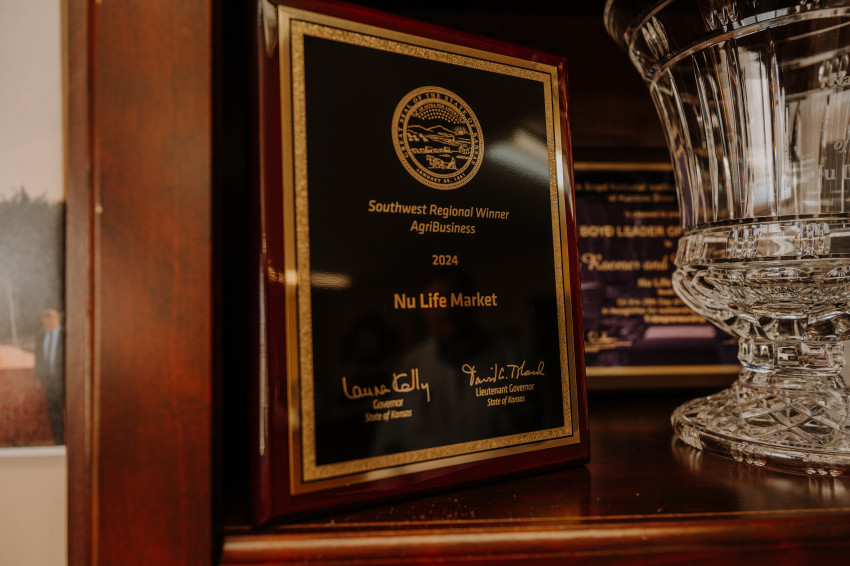 “We’re really excited about the growth and consumer demand and the characteristics that sorghum offers,” Roemer says. “Around 150 to 200 products are out there, and we’re responsible for most of those.”
“We’re really excited about the growth and consumer demand and the characteristics that sorghum offers,” Roemer says. “Around 150 to 200 products are out there, and we’re responsible for most of those.”
From growing sorghum to processing the grain into allergen-free, market-ready products, each stage of the supply chain is marked by innovation and opportunity. Growing sorghum’s presence and consumer awareness is taking hold.
“Our kids eat it; we serve it especially in the wintertime in soups and stews,” Macey says. “I would compare it to a quinoa kind of texture — it’s just a little bit larger. It’s really easy to cook, and it’s being incorporated into everything from healthy snack foods to school meals. Hopefully we’ll even see 90-second sorghum packets on grocery store shelves in the future. Consumer awareness of products with sorghum is something we’re working on in the industry.”
According to the Sorghum Checkoff, retail sales of food products containing sorghum increased 34 percent in 2022, and the global sorghum market size is anticipated to grow 5.4 percent from 2024 to 2030. Milo’s drought-tolerant and gluten-free qualities make it an attractive option for farmers and consumers alike. Because of its versatility in applications such as livestock feed, biofuel and products on grocery store shelves, it has made a name for itself as an essential crop — whether you call it sorghum or milo.


